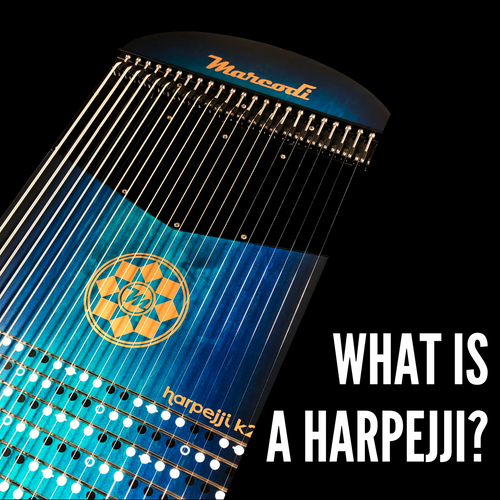Harpejji
/ har-pedge-ee /
A stringed and fretted electric instrument that is played by tapping or strumming the strings.
Origins
Developed in 2001 by Tim Meeks, the harpejji was created to bridge the gap between the piano and the guitar. Inspired by the StarrBoard and Chapman Stick®, Tim set out to create an instrument that had characteristics of a guitar but was intuitive for keyboardists. Early on in the harpejji story, harpejjis were assembled in a chicken coop in rural Maryland. Since then, the production of harpejjis has increased and as of 2023 over 1,200 harpejjis have been produced and sold world-wide.
(Tim Meeks Holding the first Harpejji body)
How It Works
The harpejji is an analog instrument with real strings and real frets. At rest, all strings on the harpejji are electronically muted. A sound is made on the instrument by tapping a string to the fret and holding to sustain it. The electrical contact between the strin and fret deactivates the mute. This technology is called Electronic Muting. Electronic muting allows you to strum a multitude of strings without hearing unfretted strings. The result is that there are no open strings on a harpejji.
Tuning and Note Layout
The harpejji is tuned in whole tones and each fret is a semitone apart. Whole tone tuning separates the 12 notes of western music into two scales (1) A, B, C#, D#, F, G and (2) A#, C, D, E, F#, G#. Each of these scales layered on top of each other allows for a cisual pattern of white and black notes reminiscent of a piano. The white markers represent the natural notes and the black markers represent the sharps and flats, just as on a piano. All C notes are denoted by a hole for easy navigation.
Techniques
Tapping: Tapping is one of the main techniques used to play the harpejji. By simply tapping a string to a fret you play the desired note.
Strumming: You can strum the strings by fretting your desired notes or chords with one hand while strumming the strings with your free hand.
Bending: Change the pitch of a note by bending the string to the left or right.
Sliding: You can slide by moving your finger up or down the string to other frets.
Harmonics: There are a couple ways to play harmonics on the harpejji. One, by lightly fretting your desired note with one hand and striking the string with your free hand at intervals of 3, 5, 7, 9, 12... frets away from the note you are playing. Another way is to rest your finger delicately on the desired harmonic and tapping a note on a fret below.
Hammer-ons and pull-offs: To play a hammer-on you must first play a note and while letting it ring out, then you play a higher fret on the same string while holding the first note creating the "Hammer-on" effect. Pull-offs are created by fretting 2 notes on the same string and "pulling off" the higher note.
Chords
Check out our Harpejji Chord Booklet
How to tune a harpejji
Tuning a harpejji is a very simple pocess. First you'll need to insert the included tuning wrench into the tuner screw for the string.being tuned Then play the string at the 1st fret. Rotate the tuning wrench clockwise to raise the pitch and counter-clockwise to lower the pitch. An electronic tuner can be used to indicate when the string is in tune.
Knobs and Inputs
Master Volume control (Left), Tone Control (Right)
1/4 Inch Jack (Middle) and 9v power jack (Right)
Changing Strings
Harpejjis use regular electric gutiar and bass strings. As long as the strings do not having a coating on them or have a painted ball end they will work! We sell string packs for all 3 harpejji models on our website.
What Gear is Needed?
Amps:The harpejji is an electric instrument as with an electric guitar you need some sort of amplifier. We've found that keyboard amps work great to achieve a clean unaltered tone. Electric guitar and bass amplifiers are also good options for the harpejji. The harpejji k24 has a stereo output Y cable to split the treble and bass strings. For that model you'll need 1 of 3 things.
- An amp with two inputs
- Two seperate amps
- A summing box
Instrument Stand: The harpejji is designed to be played on a stand. We've listed a couple of our favorite stands in our FAQ under "What kind of stand should I get for my harpejji?"
Cables and Wires: All harpejjis need to be plugged into an electrical outlet via the provided 9v DC center positive power adapter (this is included with your harpejji order) A standard 1/4 inch instrument cable (guitar cable) is used to connect the harpejji u12 and g16 into an amplifier. A 1/4" Y cable is required for the harpejji k24 (Y cables are included with your harpejji k24 order).
Tuner: Like most stringed instruments, the harpejji needs to be periodically tuned. We recommend using electronic tuners for this.
9V Power adapter included


2 comments
Jeannette
Such a wonderful instrument!!! The inventor is a marvel! It’s like putting a grande piano into a briefcase or a back pack. And the sound is rich and full. I love it.
Allison
Man, I would LOVE to see Yngwie Malmsteen get hold of one of these!
Leave a comment
All comments are moderated before being published.
This site is protected by hCaptcha and the hCaptcha Privacy Policy and Terms of Service apply.